This site uses cookies as defined in our Cookie Policy, by continuing to use this site you agree to their use.
Continue
| Arrive | Depart | ||||||
| 19th19 | JulJul | 202525 | Civitavecchia, Italy, embark on the Star Flyer | ||||
Italy's vibrant capital lives in the present, but no other city on earth evokes its past so powerfully. For over 2,500 years, emperors, popes, artists, and common citizens have left their mark here. Archaeological remains from ancient Rome, art-stuffed churches, and the treasures of Vatican City vie for your attention, but Rome is also a wonderful place to practice the Italian-perfected il dolce far niente, the sweet art of idleness. Your most memorable experiences may include sitting at a caffè in the Campo de' Fiori or strolling in a beguiling piazza. Civitavecchia is an important seaport serving Rome, the Italian capital. As a key entry point for Mediterranean cruises and ferries crossing the Tyrrhenian Sea, Civitavecchia offers a gateway to a variety of destinations in Italy and beyond. The city is 70 km from Rome and 62 km to Fiumiccino airport. | |||||||
| 20th20 | JulJul | 202525 | Ponza Island, Italy | ||||
| The pastel houses of Ponza Town rise in neat terraced rows from the busy harbour where sleekly groomed yachts and ramshackle fishing boats moor side by side. Happily, there are few tourists here, so it's a delight to wander through the unspoiled town. | |||||||
| 21st21 | JulJul | 202525 | Amalfi, Italy | ||||
At first glance, it's hard to imagine that this resort destination was one of the world's great naval powers, and a sturdy rival of Genoa and Pisa for control of the Mediterranean in the 11th and 12th centuries. Once the seat of the Amalfi Maritime Republic, the town is set in a verdant valley of the Lattari Mountains, with cream-colored and pastel-hued buildings tightly packing a gorge on the Bay of Salerno. The harbor, which once launched the greatest fleet in Italy, now bobs with ferries and blue-and-white fishing boats. The main street, lined with shops and pasticcerie, has replaced a raging mountain torrent, and terraced hills flaunt the green and gold of lemon groves. Bearing testimony to its great trade with Tunis, Tripoli, and Algiers, Amalfi remains honeycombed with Arab-Sicilian cloisters and covered passages. In a way Amalfi has become great again, showing off its medieval glory days with sea pageants, convents-turned-hotels, ancient paper mills, covered streets, and its glimmering cathedral. During the Middle Ages, Amalfi was a powerful republic of 70,000 people, rivalling nearby Ravello. For a sense of Amalfi's medieval glory, wander through the grand Duomo, containing the remains of St. Andrew. Amalfi is a magnificent coastal town offering an enchanting blend of natural beauty, rich history and Mediterranean charm. | |||||||
| 22nd22 | JulJul | 202525 | Messina, Italy | ||||
Home to the Museo Regionale of Messina, known for featuring two of Caravaggio's paintings, the city is also famous for having been the capital of the ancient kingdom of Sicily. Messina was a major transport hub for centuries and remains a gateway to the island of Sicily. Messina is home to one of Sicilian’s finest cathedrals which has the largest and most complex mechanical and astronomical clock of the world. Make sure you try the lemon granita (shaved ice), or the famous mezza con panna al caffé, a half glass of coffee-flavoured granita and cream and don't hesitate to take an excursion to discover the Theatre of Taormina. | |||||||
| 23rd23 | JulJul | 202525 | At Sea | ||||
| 24th24 | JulJul | 202525 | Corfu, Greece | ||||
Corfu town today is a vivid tapestry of cultures—a sophisticated weave, where charm, history, and natural beauty blend. Located about midway along the island's east coast, this spectacularly lively capital is the cultural heart of Corfu and has a remarkable historic center that UNESCO designated as a World Heritage Site in 2007. All ships and planes dock or land near Corfu town, which occupies a small peninsula jutting into the Ionian Sea.Whether arriving by ferry from mainland Greece or Italy, from another island, or directly by plane, catch your breath by first relaxing with a coffee or a gelato in Corfu town's shaded Liston Arcade, then stroll the narrow lanes of its pedestrians-only quarter. For an overview of the immediate area, and a quick tour of Mon Repos palace, hop on the little tourist train that runs from May to September. Corfu town has a different feel at night, so book a table at one of its famed tavernas to savor the island's unique cuisine.The best way to get around Corfu town is on foot. The town is small enough so that you can easily walk to every sight. There are local buses, but they do not thread their way into the streets (many now car-free) of the historic center. If you are arriving by ferry or plane, it's best to take a taxi to your hotel. Expect to pay about €10 from the airport or ferry terminal to a hotel in Corfu town. If there are no taxis waiting, you can call for one. The lushest (and some say the loveliest) of all the Greek Islands, Corfu lies just a stone's throw from the Albanian coast. Nowhere is the stunning natural beauty of Corfu more evident than in the small village of Paleocastritsa, where legend says Odysseus was washed ashore to be rescued by Nausicaa. | |||||||
| 25th25 | JulJul | 202525 | At Sea | ||||
| 26th26 | JulJul | 202525 | Kotor, Montenegro | ||||
Backed by imposing mountains, tiny Kotor lies hidden from the open sea, tucked into the deepest channel of the Bokor Kotorska (Kotor Bay), which is Europe's most southerly fjord. To many, this town is more charming than its sister UNESCO World Heritage Site, Dubrovnik, retaining more authenticity, but with fewer tourists and spared the war damage and subsequent rebuilding which has given Dubrovnik something of a Disney feel.Kotor's medieval Stari Grad (Old Town) is enclosed within well-preserved defensive walls built between the 9th and 18th centuries and is presided over by a proud hilltop fortress. Within the walls, a labyrinth of winding cobbled streets leads through a series of splendid paved piazzas, rimmed by centuries-old stone buildings. The squares are now haunted by strains from buskers but although many now house trendy cafés and chic boutiques, directions are still given medieval-style by reference to the town’s landmark churches.In the Middle Ages, as Serbia's chief port, Kotor was an important economic and cultural center with its own highly regarded schools of stonemasonry and iconography. From 1391 to 1420 it was an independent city-republic and later, it spent periods under Venetian, Austrian, and French rule, though it was undoubtedly the Venetians who left the strongest impression on the city's architecture. Since the breakup of Yugoslavia, some 70% of the stone buildings in the romantic Old Town have been snapped up by foreigners, mostly Brits and Russians. Porto Montenegro, a new marina designed to accommodate some of the world’s largest super yachts, opened in nearby Tivat in 2011, and along the bay are other charming seaside villages, all with better views of the bay than the vista from Kotor itself where the waterside is congested with cruise ships and yachts. Try sleepy Muo or the settlement of Prčanj in one direction around the bay, or Perast and the Roman mosaics of Risan in the other direction. This stunning rock-walled chasm splitting the coastal mountains of Montenegro is the longest arm of the sea in southern Europe. Boka harbours one of the prettiest, unspoiled towns you'll ever see, the medieval city of Kotor. Founded by the Romans, fortified during the Byzantine era, then ruled by Venice for much of its history, Kotor has been naturally preserved by its isolation. | |||||||
| 27th27 | JulJul | 202525 | Dubrovnik, Croatia | ||||
Nothing can prepare you for your first sight of Dubrovnik. Lying 216 km (135 miles) southeast of Split and commanding a jaw-dropping coastal location, it is one of the world's most beautiful fortified cities. Its massive stone ramparts and fortress towers curve around a tiny harbor, enclosing graduated ridges of sun-bleached orange-tiled roofs, copper domes, and elegant bell towers. Your imagination will run wild picturing what it looked like seven centuries ago when the walls were built, without any suburbs or highways around it, just this magnificent stone city rising out of the sea.In the 7th century AD, residents of the Roman city Epidaurum (now Cavtat) fled the Avars and Slavs of the north and founded a new settlement on a small rocky island, which they named Laus, and later Ragusa. On the mainland hillside opposite the island, the Slav settlement called Dubrovnik grew up. In the 12th century the narrow channel separating the two settlements was filled in (now the main street through the Old Town, called Stradun), and Ragusa and Dubrovnik became one. The city was surrounded by defensive walls during the 13th century, and these were reinforced with towers and bastions in the late 15th century.From 1358 to 1808 the city thrived as a powerful and remarkably sophisticated independent republic, reaching its golden age during the 16th century. In 1667 many of its splendid Gothic and Renaissance buildings were destroyed by an earthquake. The defensive walls survived the disaster, and the city was rebuilt in baroque style.Dubrovnik lost its independence to Napoléon in 1808, and in 1815 passed to Austria-Hungary. During the 20th century, as part of Yugoslavia, the city became a popular tourist destination, and in 1979 it was listed as a UNESCO World Heritage Site. During the war for independence, it came under heavy siege. Thanks to careful restoration, few traces of damage remain; however, there are maps inside the Pile and Ploče Gates illustrating the points around the city where damage was done. It’s only when you experience Dubrovnik yourself that you can understand what a treasure the world nearly lost It was George Bernard Shaw who said: 'Those who seek paradise on earth should come to Dubrovnik.' Indeed, Dubrovnik is a treasure by any measure made more precious by its miraculous restoration. Crowned by the Minceta Tower, the 10th century city walls are the proud symbol of Dubrovnik's colourful history. | |||||||
| 28th28 | JulJul | 202525 | Hvar Island, Croatia | ||||
The Croatian island of Hvar bills itself as the "sunniest island in the Adriatic." Not only does it have the figures to back up this claim—an annual average of 2,724 hours of sunshine—but it also makes visitors a sporting proposition, offering them a money-back guarantee if there are seven consecutive days of snow (snow has been known to fall here; the last time being February 2012). The heavenly scent of lavender perfumes the air in the fields and valleys around the island of Hvar. Idyllically located just off the Dalmatian Coast, the island and the little port named after it have been a favorite getaway ever since the time of the Romans, the Byzantines, the Venetians and even Austro-Hungarian royalty. | |||||||
| 29th29 | JulJul | 202525 | Lošinj & Cres Islands, Croatia | ||||
| The warm sands of Cikat Bay, situated near the port of Mali Losinj where we anchor, are an irresistible magnet for beachgoers. And no wonder, the beach is 30 kilometres long and offers every watersport imaginable. For those who prefer to wander farther afield, our bicycle tour takes you around the island past the fortified town of Veli Losinj. | |||||||
| 30th30 | JulJul | 202525 | Venice, Italy, disembark the Star Flyer | ||||
Venice is a city unlike any other. No matter how often you've seen it in photos and films, the real thing is more dreamlike than you could imagine. With canals where streets should be, water shimmers everywhere. The fabulous palaces and churches reflect centuries of history in what was a wealthy trading center between Europe and the Orient. Getting lost in the narrow alleyways is a quintessential part of exploring Venice, but at some point you'll almost surely end up in Piazza San Marco, where tourists and locals congregate for a coffee or an aperitif. Venice is the heart and soul of romance. Cast your eye on the rounded domes of San Marco, take a deep breath at the Bridge of Sighs, gaze on the golden lions and the Renaissance glories of the Doge's Palace, listen for the ghosts of Verdi, Puccini and Caruso at La Fenice Opera House, gape at the classic Palladian proportions of the Church of San Giorgio Maggiore, glide in a gondola down the Grand Canal. And know that love is always in the air in Venice. | |||||||





The images shown are for illustration purposes only and may not be an exact representation of what you find on the ship.
The images shown are for illustration purposes only and may not be an exact representation of what you find on the ship.
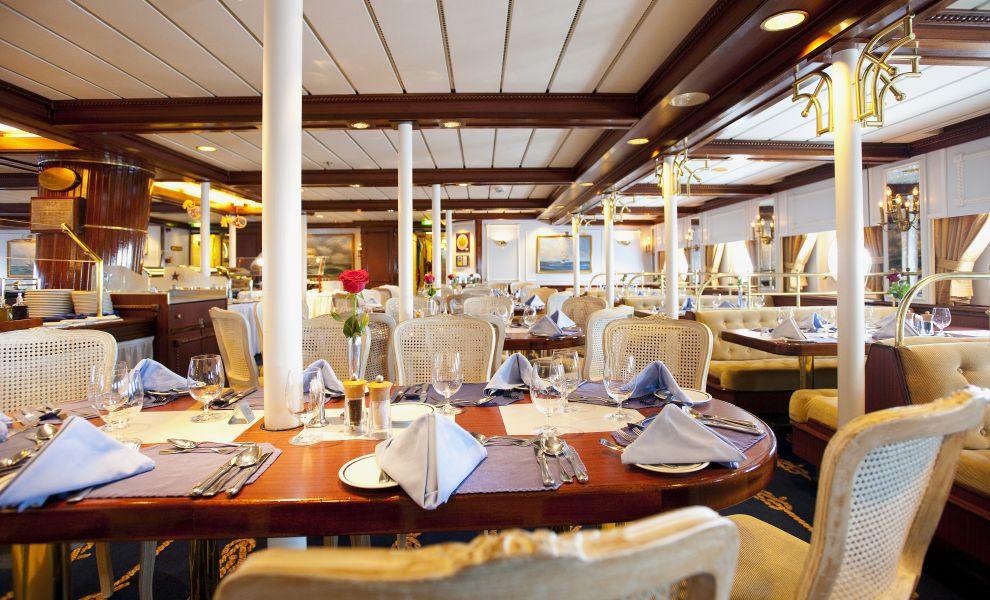
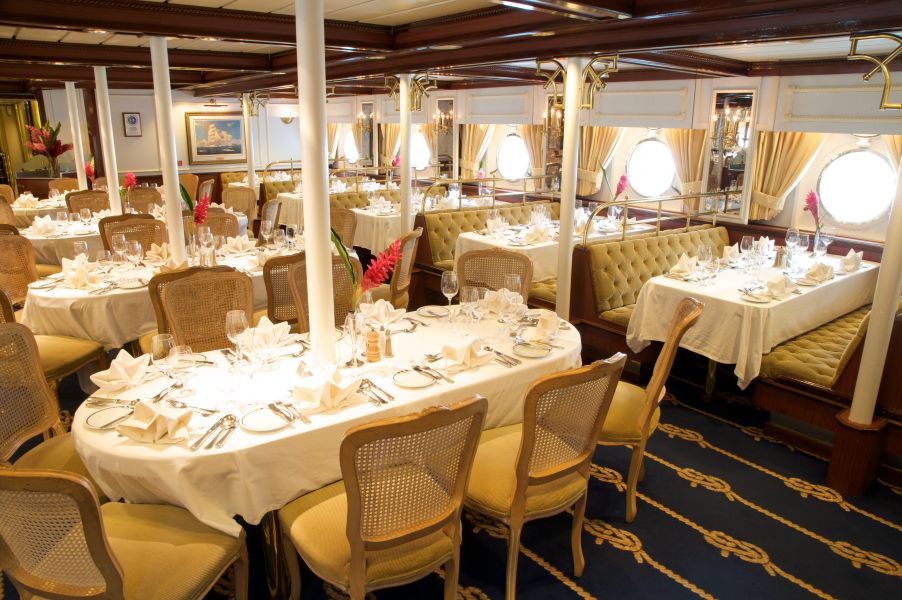
When you rise, help yourself to a continental breakfast with Parisian croissants or sweet Danish pastries. Or savour a full breakfast with fresh tropical fruit and crisp bacon, grilled sausage and omelettes cooked to order in the dining room.
At lunch, a marvellous buffet of seafood, salads and grilled favourites awaits your pleasure. If the day includes a stop at one of the paradisical islands we frequent, you might also be treated to a succulent outdoor barbecue on shore.
When evening comes, our elegantly appointed dining room becomes the setting for the chef’s finest culinary presentations, designed to please the eye and the palate, complemented by a selection of equally fine wines.
You’ll find our service to be friendly and gracious, befitting a tasteful restaurant. Of course, we would not presume to dictate your seating preferences. On all three ships, you are free to dine when and with whomever you wish - including with our officers, who join our guests in the dining room most nights. The dress code? No need for formal gowns and black tie, casual elegance is the order of the day and every single night.
The images shown are for illustration purposes only and may not be an exact representation of what you find on the ship.

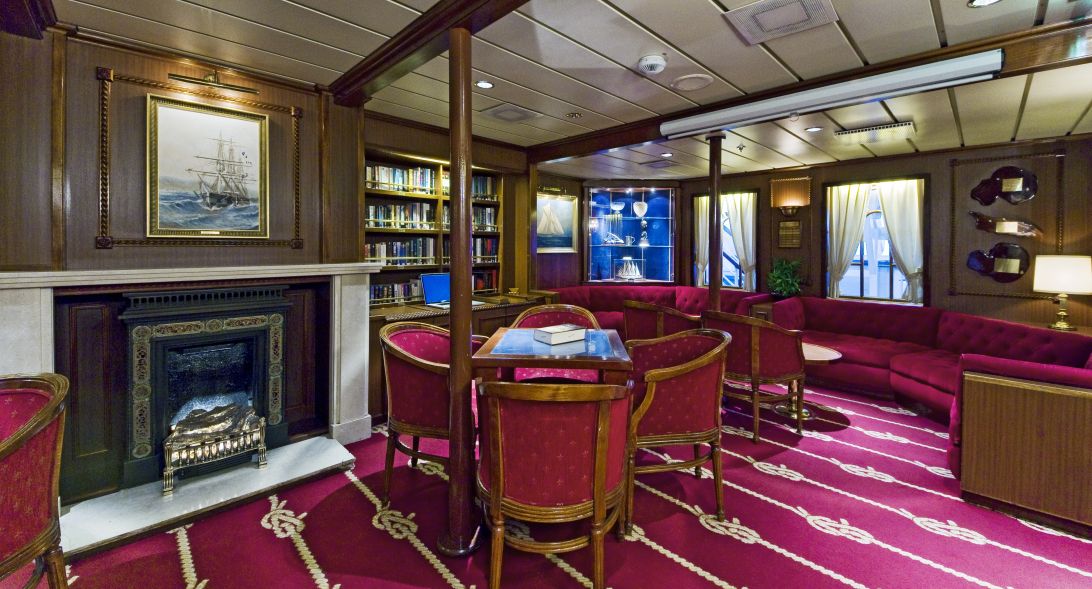
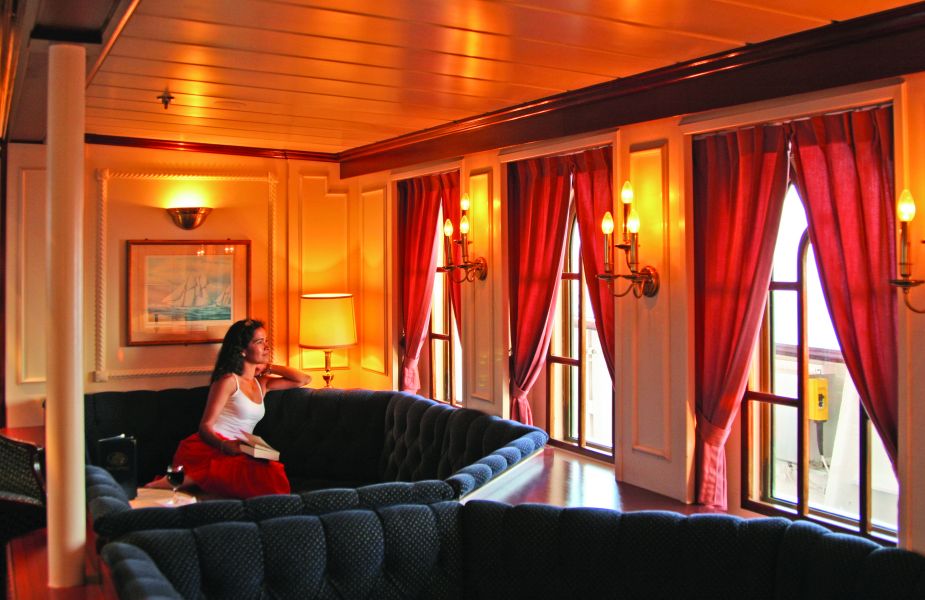
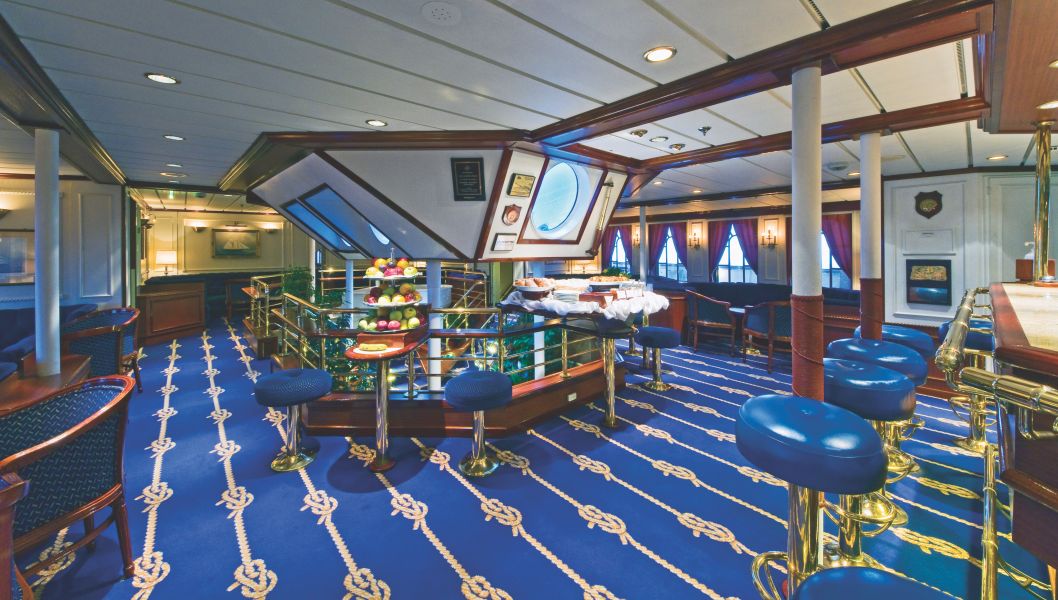
If your time isn't taken up by searching out distant lands from the crow’s nest or enjoying a lovingly prepared meal in the dining room; you can always take a seat in the Observation Lounge, find solitude in the Library, enjoy a drink in the Tropical Bar, or enjoy some live music in the Piano Bar.
The images shown are for illustration purposes only and may not be an exact representation of what you find on the ship.
The images shown are for illustration purposes only and may not be an exact representation of what you find on the ship.
| 11 nights aboard the Star Flyer | |||
| Water sports including water skiing & snorkelling | |||
| Transportation into town (available most ports) | |||
| Unique learn to sail experiences | |||
| Port Taxes and Fees | |||
 | ABTA and ATOL Protection* | ||
Date 19th Jul 2025 |
Nts 11 |
Please call for availability |
| Interior staterooms from | £3,440pp | ||
| CAT6 | Category 6 | £3,440pp | |
| Oceanview staterooms from | £3,715pp | ||
| CAT5 | Category 5 | £3,715pp | |
| CAT4 | Category 4 | £4,015pp | |
| CAT3 | Category 3 | £4,240pp | |
| CAT2 | Category 2 | £4,450pp | |
| CAT1 | Category 1 | £4,935pp | |
| OWNC | Owners Cabin | £6,330pp | |
Fusion Cruises when selling travel arrangements is a trading name of The Midcounties Co-operative Ltd. Fusion Cruises is an Accredited Body Member of Midcounties Co-operative Travel Consortium. (ABTA:P6652, ATOL:6053).
Book with Confidence. We are a Member of ABTA which means you have the benefit of ABTA’s assistance and Code of Conduct.
Some of the flights and flight-inclusive holidays on this website are financially protected by the ATOL scheme but ATOL protection does not apply to all holiday and travel services offered on this website. This website will provide you with information on the protection that applies in the case of each holiday and travel service offered before you make your booking. If you do not receive an ATOL Certificate then the booking will not be ATOL protected. If you do receive an ATOL Certificate but all parts of your trip are not listed on it, those parts will not be ATOL protected. Please see our booking conditions for information, or for more information about financial protection and the ATOL Certificate go to: www.caa.co.uk
